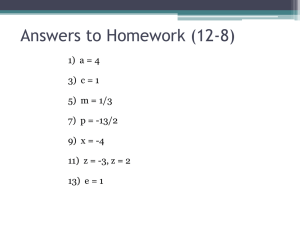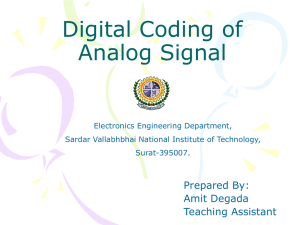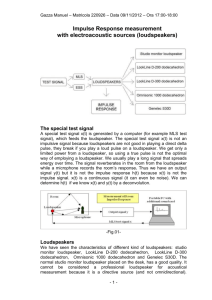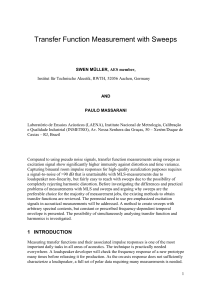Modeling the effects of air currents on acoustic
advertisement
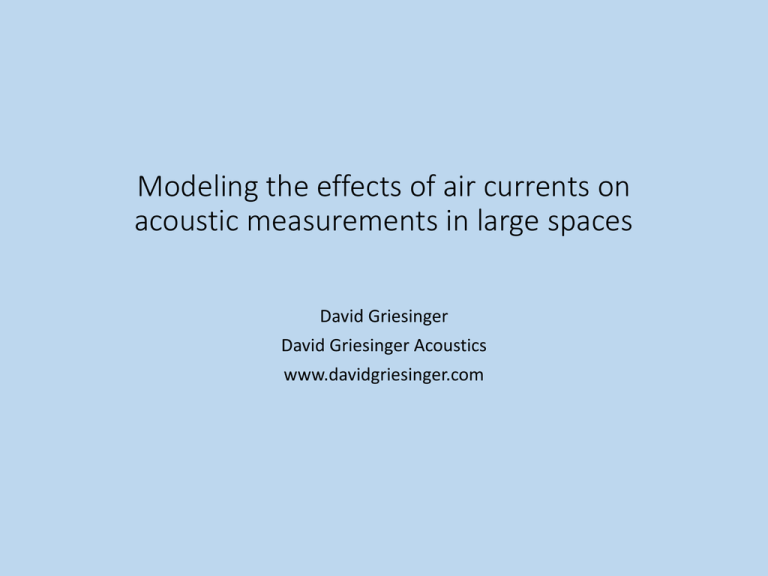
Modeling the effects of air currents on acoustic measurements in large spaces David Griesinger David Griesinger Acoustics www.davidgriesinger.com Sabine • Sabine discovered that in most rooms sound decays logarithmically at a constant rate. • He measured the decay by filling the space with tone from an organ pipe, and timing the time before the sound became inaudible with a stopwatch. • He could do this with considerable precision. • He also knew that sound power increases in a room as a sound continues. • Sound pressure rises until the available absorption is able to dissipate all the power from the source. • Sabine understood that speech is incomprehensible when reverberation from a previous syllable masks a succeeding syllable. • Such masking depends on the reverberation time, the reverberant level, and the length of a sound. Short, detached sounds can overcome long RTs. • But small rooms with little absorption can be more garbled than large spaces with long reverberation times. • The bottom line: • We should not design spaces where reverberation masks the onsets of sounds! • But Sabine’s method of measuring RT works quite well! Noise decays • In the 1960’s the standard way of measuring RT was with a logarithmic chart recorder. • The room was filled with a continuous noise which was switched off just as the recorder was started. A jagged slope recorded the decay. • The paper was rewound, and the measurement was repeated. After 5 or more trials there was an easily measured line on the paper. • The procedure was tedious, but the result was accurate. • The result is not an impulse response. It is an accurate picture of what happens in a room with a sound of finite length Long notes can be masked by reverb, while short notes are clear Chart recorder graph of a 1.5s RT and a long note The reverberant level builds up as the note is held The same with a short (0.1s) note with same sound power These graphs are not impulse responses. They show what you actually hear – the decay of notes of different lengths that suddenly stop. They graph the result of the room on sound, and not the room itself. Jordan’s definition of EDT gives insight into the contribution of the direct sound to the total sound field. Schroeder did not understand this meaning, and re-defined EDT to be the slope of the first 10dB of decay. This is now the ISO3382 standard. Its meaning is unclear. Impulse responses • Mathematicians are fond of impulse responses. • They carry much more information about how sound reflects around a room than noise decays. • But they require an impulse to excite the space. If you want to record a decay with a S/N of 40dB, the sound pressure at the beginning of the decay must be one hundred times larger than the noise level in the room. • Achieving a high level at a considerable distance from the source requires a strong impulse – typically from a pistol or a small cannon. • Firearms are loud, dangerous, often illegal, and are not omnidirectional, particularly at low frequencies. • But the reverberation times, and the reflection amplitudes, are accurate. • In theory any repeatable signal of finite length can be used to excite a room. • An impulse response can be obtained by dividing the room signal by the stimulus in the frequency domain. • In 1975 Schroeder proposed using maximum length sequences of ones and zeroes (MLS) to excite rooms. They have a white spectrum, are repeatable, and can be deconvolved into impulses without a hardware multiplier. • The method was rapidly adopted, and is still commonly used. MLS sequences are inherently noisy Green: A 1.5s RT decaying noise impulse response measured with a 2second MLS sequence (ones and zeros) . Blue: a 2 second log sine sweep. 250Hz octave band The MLS measurement has a S/N of about 34dB, the sine sweep 60dB. The noise in MLS is due to the use of ones and zeroes as a stimulus. If we use multivalued random noise as a stimulus the noise floor is identical to that of the sine sweep. – but the crest factor is much larger than either MLS or a sine-sweep. MLS and distortion Harmonic distortion in the measurement system adds pseudo reflections. - Note in the picture below that the bumps in what looks like the noise floor are identical. They are artifacts of the particular sequence. A two second white noise sequence deconvolved with its time inverse. Green: 5% third harmonic distortion Blue: 1% harmonic distortion A one-second RT decaying noise deconvolved from a 2 second noise sequence with no distortion. The S/N is ~44dB at 2000Hz. Logarithmic sine sweeps are superior to Noise or MLS sequences with respect to distortion. Distortion produces artifacts that deconvolve to negative time, where they can be observed and measured. Averaging to reduce noise • All convolution measurement methods rely on the fact that when we sum two independent noise signals the power rises by 3dB. But if we sum two identical signals the power rises by 6dB. • Thus we can extract a stationary signal from random noise by averaging many measurements. The signal to noise ratio increases by 3dB for every doubling of the number of measurements. • But the signal we are measuring must completely stable, both in amplitude and phase. • If at some point in time the signal starts to behave randomly, there is no advantage to averaging. Both the signal and the noise increase 3dB with every doubling. How stable are room impulse responses? And what measures does instability affect? • Many years ago I was called by a scientist at a major consulting firm that had just finished a new concert hall. • They had measured the RT of the hall with a pistol and with the newly introduced MLS measurement software. • The RT at 2000Hz was shorter in the MLS result by 30% • I told them air currents were the problem, and that the pistol was correct. • How common is this problem? And what are the effects? • I decided to model it Modeling air currents with random walks • Convolution methods are commonly used by coherently averaging several measurements. • I decided to model air currents by averaging several identical IRs who’s time-base had been slightly modified progressively with time. • The time base modification was done by a “random walk” similar to the motion of a small particle jostled by Brownian motion. Here are eight typical random walks, moving randomly by a random function of +- 0.1 samples per sample. They are used to modify a one second RT 1.5 seconds long. With a sample rate of 44.1KHz these random walks produce a maximum pitch-shift of .04%. The mean absolute value of all 32 walks is 8 samples, 2.4 inches per second, or 0.13 miles per hour. They have a LARGE effect on measurements! 1sRTs measured in one octave bands Green: 32 averages Blue: 8 averages 8kHz Green: RT = .92 blue, 1.0 Green is 6dB higher than blue! 4kHz Green early 0.2sRT, late 0.82 Green is initially 12dB higher than blue 2kHz Green early 0.28s. Blue early 0.52s 1kHz Green 0.77 Blue 0.81 Green is finally 12 dB higher. Boston Symphony Hall measurements In 2008 I made a set of soundfield and binaural measurements in BSH using a Genelec 1029 loudspeaker just to the audience right of the conductor. I used a 2 second sine sweep as a stimulus. I have been using the data to understand why the hall sounds as it does. There are a great many outstanding seats in the hall, and many less than outstanding seats. I have binaural recordings of live music in many of them, which I can listen to while pondering the data. On April 18th 2014 I was able to duplicate the soundfield data using tiny balloons as stimuli. The balloons are amazing – bursting in less than a millisecond, and yielding a peak sound pressure of 94dB at 10 meters. Two impulse responses from Boston Symphony Hall with a 2 second sweep 2008 Binaural impulse from BSH row R seat 11 Same, Row DD, seat 11 C80=C80 = 0.85dB IACC80 = .68 LOC = 0.21 IACC80 = 0.2 LOC = -1.2 9.1dB ISO 3382 fails to quantify the sound in these seats! Both C80 and IACC80 predict the opposite of what we hear! Compare the sine sweep in 2008 to a 5” balloon pop in 2014 BSH row R seat 11 Binarual data from 2008: LOC = +9dB SF data from 2014: LOC = ~+2dB I had always been suspicious about the very high LOC value in the 2008 measurement. The value from 2014 is lower than I would expect from the very good sound I hear there. The stimulus is omnidirectional, and the orchestra is not. Ning’s 2 second sweep data • Ning Xiang and his students were also measuring in BSH. We measured one seat in common: row U seat 14 – one with very good sound. • We attempted to measure the effect of air currents by comparing the data from a single sweep with data from averaging two and ten measurements of the same sweep 5 seconds apart. • We expected to see differences in the RT data at 2kHz and above. • But there were no significant differences! Compare sound decays at U14 with no averages and 10 averages of a two second sweep 4kHz octave band data from 10 averages 4kHz octave band data with no averages The RT data are clearly the same! Does this mean that there are no significant air currents? Look more closely: if there were no air currents the two decays should be identical. But they are not! Past the first 100ms they are different! If no averaging and two averages are the same, we can subtract them and get zero The direct sound is the same – but by the first reflection at 27ms the waveforms are quite different. And the random stuff between reflections is different too. The spectrum of the direct sound from a single measurement is in blue, and the spectrum from subtracting a two measurement average is in red. The top graph is for the direct sound The next graph is for the first reflection at 27ms. The coherence at 3kH is only ~3dB. The second reflection at 83ms shows even less coherence. These graphs show a method of testing for the presence of air currents and the validity of your data. Compare sweep data to balloon data in U 14 at 4kHz All the reflections are stronger in the balloon. The first, at 23ms is stronger by at least 3dB, the next at 83ms is stronger by more than 4dB, and the one at 143ms is completely missing in the sweep data. Why does it matter? RT values are OK! • But any measure that depends on early vs late will be wrong! Ning’s data from a 2 second single log sweep DG’s data from a 5” balloon Both from BSH seat U 14 Conclusions • In both speech and music most information is carried in frequencies above 1000Hz. We need measures that are accurate at these frequencies • Only the first 20dB of sound decay is audible in the presence of music. We do not need enormous values of S/N to find what we need to know. • The two most critical acoustic factors for human communication are: • 1. Are onsets of sounds masked by the build-up of reverberation from previous sounds? • 2. Is the direct sound component of a sound field – which contains the source azimuth, and supplies the attention-grabbing property of presence – separately audible from the hall sound? • Both these factors are falsely measured by convolution methods in large halls – even with sweep lengths as short as two seconds. • The degree to which these methods fail in small halls remains to be investigated. • Small balloons are more accurate • Their variable spectrum and usually omnidirectional radiation can perhaps be compensated if soundfield data is available. • Noise burst measurements give less information than impulse response measurements – but they are easy to make and inherently accurate. • Analyzing several with different burst lengths can probably reveal a lot about how a hall sounds with music and speech. • Alternate sweep signals might be very helpful





